GetResponse 2022 Review: A Powerful All-In-One Marketing Platform
We're drowning in a sea of email marketing and marketing automation tools that all do the same thing.
However, GetResponse is one of the names that comes up when discussing email marketing software.
It's one of those tools that has been around for a long time but continues to deliver year after year.
We'll try to break down GetResponse into its features and discuss its main strengths and weaknesses in this GetResponse review.
By the end, you should be able to tell whether GetResponse is powerful enough for your needs.
What exactly is GetResponse?
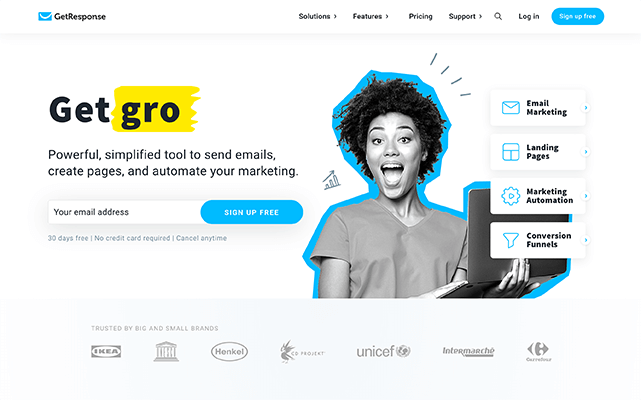
GetResponse has been around for a long time. It all began in 1997, when SEO Simon Grabowski introduced the first autoresponder.
This set off a chain reaction, beginning with the registration of www.getresponse.com a year later.
GetResponse has been expanding its features and expanding its team globally since then. The tool has also received recognition from publications such as Website Magazine, which named GetResponse the second-best email marketing provider in 2011.
But how has GetResponse managed to stay on top of its game in the face of much stiffer competition chock full of bells and whistles to the delight of users?
One of GetResponse's best qualities is its constant growth and ability to adapt to changing times. It hasn't rested on its laurels, and it continues to offer users the best email marketing features to help them grow their businesses.
GetResponse functions
Instead of gushing about how great GetResponse is, get deep into the weeds and see the tool in action.
The following are its main features and how they all work together to help your business.
Email marketing
Its flagship service is still regarded as one of the best in the industry.
GetResponse makes it simple to create beautiful emails that your subscribers will want to open.
Email creator
It all begins with selecting one of its predesigned templates.
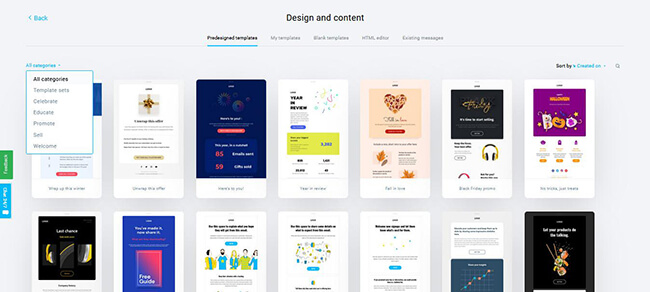
Instead of starting from scratch, simply choose which template you want to use for your email campaign. You can preview the template first to see if it matches the look and feel you want for your email.
Show only templates from the category that best fits your needs to make your search for the right template much easier.
Click on the blocks and sections you want to change from here.
Its WYSIWYG editor allows you to make changes to the page as it will appear to your subscribers once you've finished editing it.
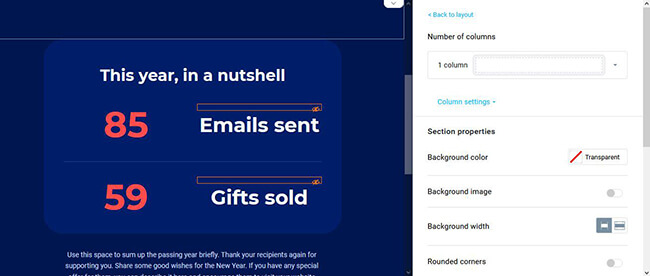
You can also change the design of each block or section by adjusting its settings. Even if you lack design skills, changing the colour or resizing the font size is simple with a few clicks.
You can even drag and drop blocks and sections to the template to further customise it.

The email editor also includes an Ecommerce section where you can add the Product box and Recommended products blocks. However, you can only use these if you have a GetResponse store.
You can save the current email design as a template if you want to use it for other campaigns. You can then save your custom design in the Design and Content section (by clicking on the My templates tab).
Once you've completed the design and determined who will receive the email, you must schedule when it will be sent to them.
You can send it right away or schedule a time for your recipients to see it.

Even better, enable Perfect timing to ensure that subscribers receive the email at the optimal time based on when they opened previous emails from you..
Autoresponders
Assume you want to send an email or a series of emails to a group of subscribers automatically. Because it is impossible to send the emails one by one, GetResponse makes this easier for you with its Autoresponders feature.
Create the first autoresponder by specifying when the email will be sent to a list subscriber.
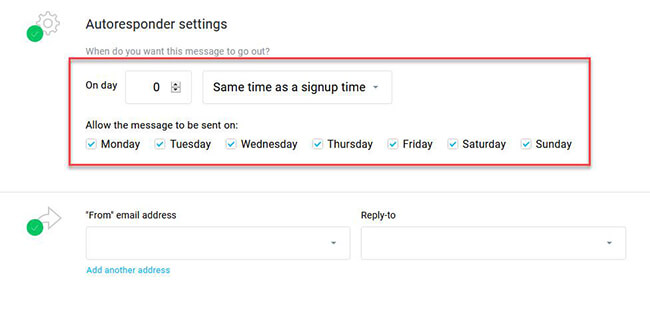
For example, you can use autoresponders to welcome new subscribers by sending them a welcome email as well as links to pages on your website that they should visit to become acquainted with your company.
After you've determined the autoresponder's schedule, you can design and publish the email in the same manner as shown above.
While sending autoresponders is an excellent way to onboard new subscribers, it becomes even more effective when combined with the marketing automation feature, which we will discuss shortly.
But, as an example, you can automate your sales and engagement by configuring multiple autoresponders to create a drip-feed campaign!
Email analytics
To ensure the success of your email campaign, you must understand how it was received by your subscribers.
Even if you believe you have created the best email campaign available, there is a chance that not all of your subscribers agree.
If anything, you need to understand how your campaign performed with your subscribers so that you can understand what you did right and/or wrong and improve your next campaign.
To do so, examine the campaign's analytics to identify the various metrics that influence its overall performance.
You can see an overview of how your list responded to one of your email campaigns from the dashboard.
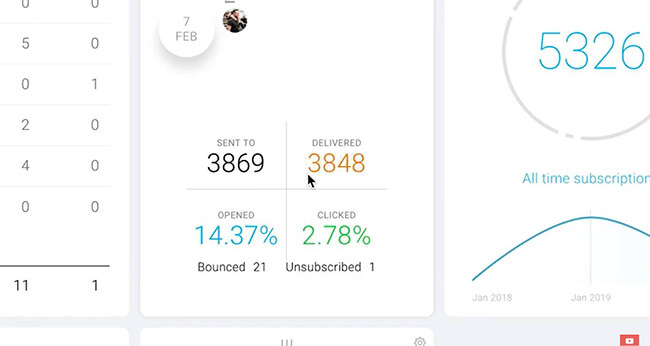
It displays the number of emails delivered to your subscribers, as well as the campaign's open and click-through rates.
More information about the campaign, such as the bounce and unsubscribe rates, as well as the number of complaints, can be found by digging deeper.
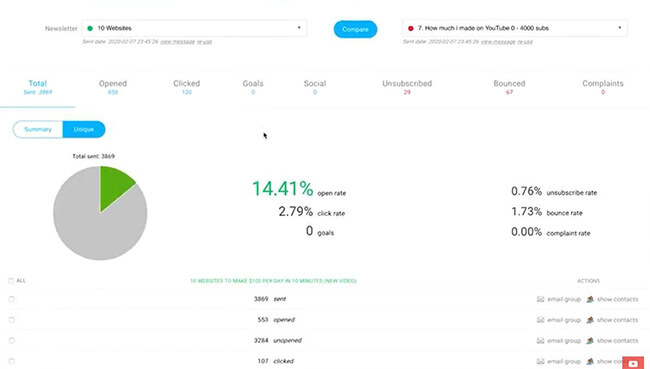
When you take all of this into account, you'll have a better idea of what made your campaign a success or failure and what you can do to improve results.
If you want to analyse your list's growth, the reports section will display it in graph format alongside other variables (demographic, subscription methods, devices).
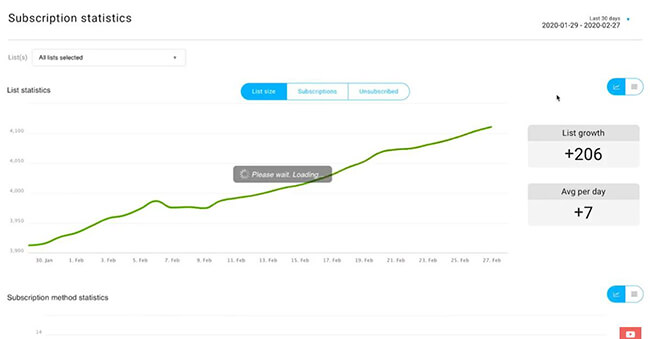
List management
When creating a list, you want people who are interested in and involved with your brand to join. However, you will only be able to do so if you can send them emails encouraging them to participate and stay active.
GetResponse's List Management feature assists you in accomplishing this by first segmenting and conditioning your subscribers.
For example, you can segment groups of people who signed up on your site using a different form with a specific message (more on this later).
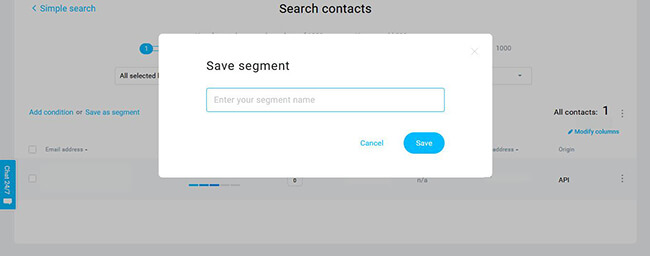
After you've created a segment for them, you can create a personalised campaign for them to receive from you.
This way, your interactions with each of your segments become more dynamic and personal, which helps to increase engagement, if not conversions.
Adding conditions to each of your subscriber lists is another way to help you manage them.

You can get more specific with your subscribers by segmenting them based on criteria such as geolocations, contact actions, and so on.
You can then group subscribers who meet certain criteria and create personalised email campaigns for each.
You can also profile each of your subscribers from List Management. To learn more about them, click on their names.
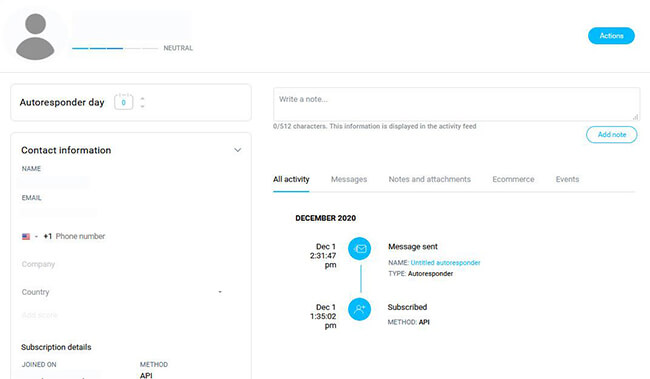
You can see their most recent activity based on the emails you sent to each of them, add notes about each, and other information that may help you convert them into customers.
GetResponse functions similarly to a CRM. Using the information provided here should assist you in profiling subscribers and providing context for each of them.
Transactional emails
People who run an e-commerce site require more from their email marketing software than just collecting subscribers and sending emails.
You'll need a tool that will send emails to people who haven't checked out their carts and receipts to customers after each transaction.
The Transactional Email feature of GetResponse allows you to connect its API or SMTP and send transactional emails to customers.
By automating this system, you can concentrate on the big picture; the tool's 99% email deliverability rate and dependable infrastructure ensure that you're not letting yourself off the hook too easily.
You can analyse and review the performance of these emails to increase your sales opportunities even further.
Sign-up forms
Of course, you can't start an email campaign unless you have subscribers to send it to.
Fortunately, GetResponse has you covered.
For starters, its sign-up form allows you to collect contact information for your list.
It is simple to create a form. Choose from four methods for creating forms and from a variety of templates organised into categories so you don't have to start from scratch.
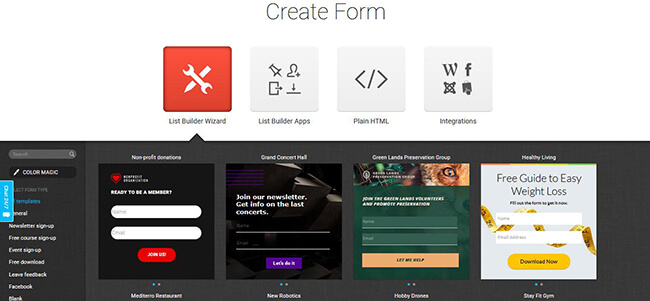
You can edit the existing fields and layout, as well as add new ones, just as you would when creating an email.
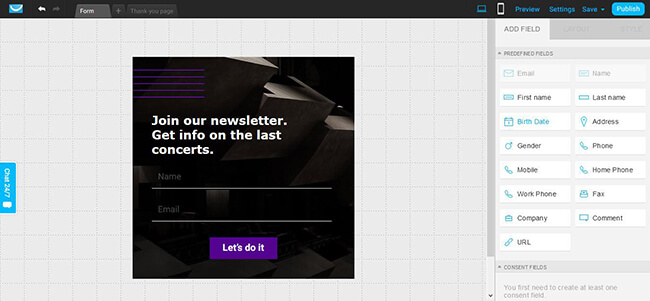
When you're finished with the form, you can embed it on your website by pasting the code into any page. You can also ask your web designer to do it for you, or GetResponse can host it on its servers. In the latter case, you'll simply need to share the URL with your audience.
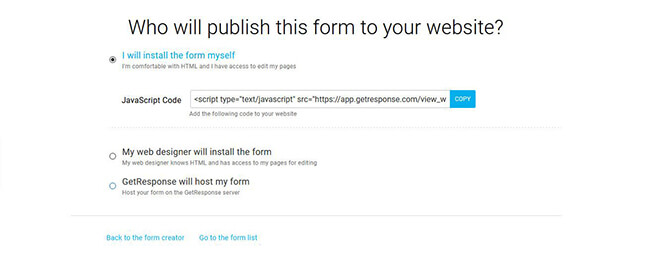
If you want to change the appearance of your form, you should be able to find it in the tool's List Builder Apps.
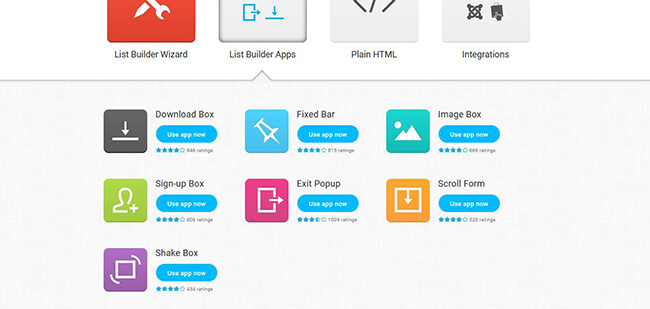
Before publishing, click on the app of the form you want to build and edit it from there.
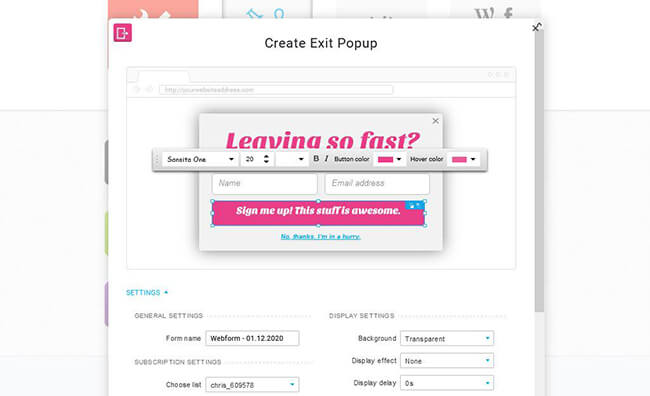
There are also options for creating the form from plain HTML (if you are comfortable with coding) or by utilising integrations or plugins from popular platforms (WordPress, Drupal, Prestashop, etc.).
Landing pages
Instead of forms, you can use landing pages to convert visitors into subscribers or even customers.
You can make one by selecting one of the available templates, which are organised by type (promotion, download, sale, etc.).
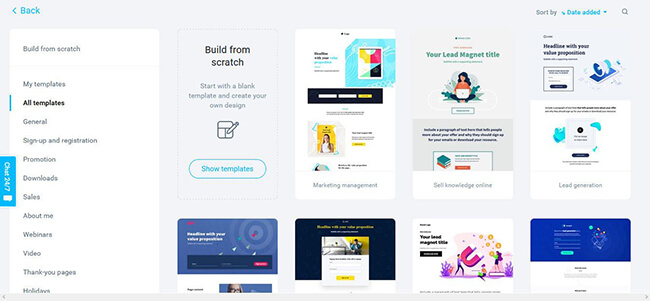
Again, thanks to its simple drag-and-drop builder, creating a landing page is a breeze.
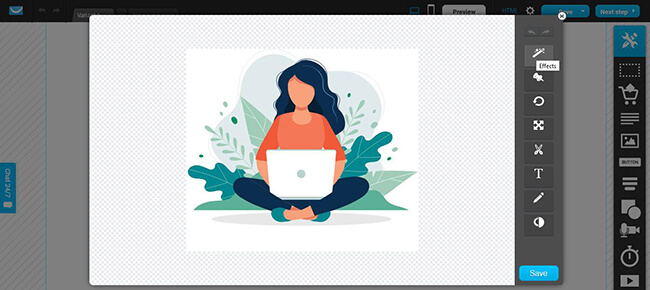
To conduct A/B testing on landing pages, click the + sign in the top bar to create as many variants as you need.
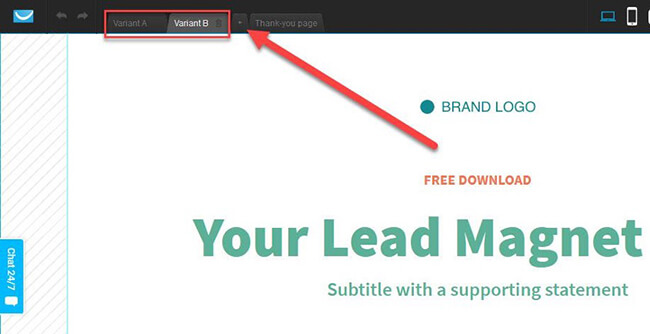
This is important in determining which variant generates the most conversions.
When you're finished with your landing page, you'll need to decide which domain you want to publish it on. GetResponse owns three preset domains.
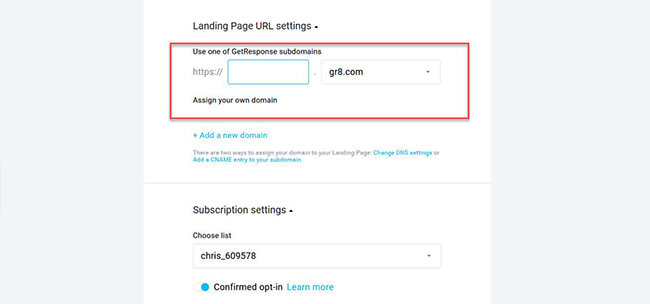
If you have a website, however, it is best to publish the landing page under your domain name for branding purposes.
Webinars
If your resource guides aren't increasing your company's sales, it's time to step up your game with webinars.
Hosting online presentations where your audience can join to learn more about a topic is another excellent way to introduce them to your products and services.
They joined your webinar because they are interested in what you have to say and offer. As a result, with just one webinar session, you can expect to close more customers and clients.
GetResponse is by far the only email marketing platform that includes webinar functionality. What's more, it integrates well with its other features, making it much easier to set up webinars than using a third-party tool.
To create a webinar, you must first configure its details, such as the URL of the webinar page, the date, the duration, and so on.
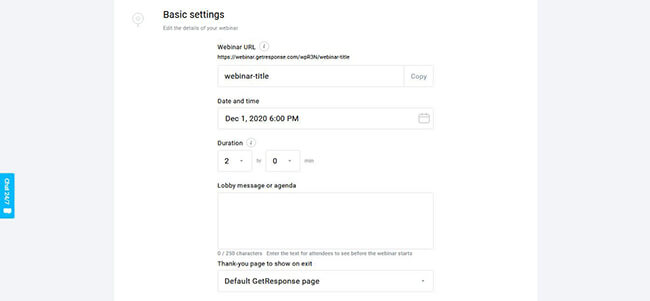
You can also set up the webinar to collect registrants ahead of time and assign them to which email list they will be added to.
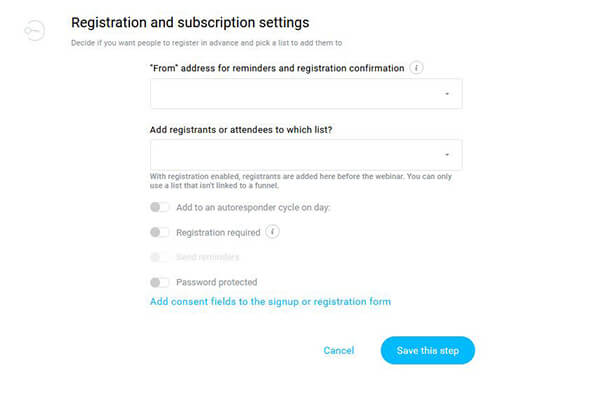
After saving the settings and moving on to the next step, you can create forms and landing pages for your audience to pre-register for the webinar.
You can then set up autoresponders to remind them about the webinar and keep them up to date on any changes.
You can promote your webinar in a newsletter to your existing list so that they can sign up and be informed about it as well.
This is where the fun begins once the webinar has begun.

GetResponse provides more than enough tools to run a capable webinar where you can take questions and interact with attendees in real time.
You can record the entire webinar and share the link with those who missed it so they can watch it whenever they are available.
Marketing automation
If you want to increase sales and revenue on autopilot, use GetResponse's marketing automation features.
As previously stated, you can create multiple autoresponders to create a drip-feed campaign. This enables you to put the software to use by having it automatically send emails to a segment of your list.
To accomplish this, you must design a workflow that is geared toward your goal.
While you can create the workflow from scratch, you can also select from pre-made workflow templates with built-in elements.
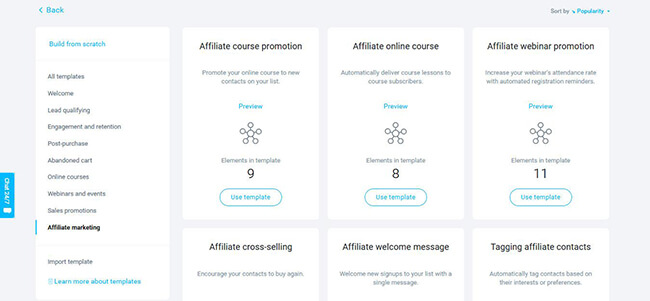
The workflow builder visually displays the emails that will be sent to your subscribers.
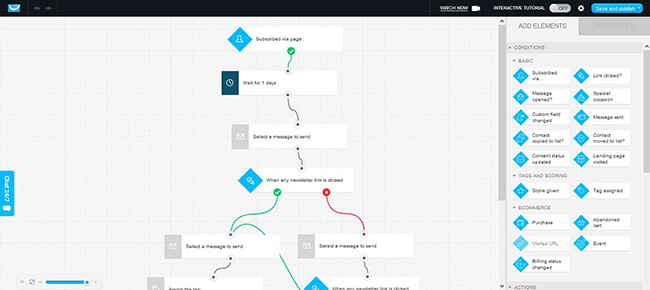
You can customise and personalise the workflow by adding elements from the right side of the screen to the template.
The conditional logic element is what makes marketing automation tools so powerful.
Every email campaign's goal is to get people to the end of the campaign by allowing the workflow to do the work for you.
As a result of incorporating conditional logic into the equation, you can generate personalised automated emails based on their actions.
For example, recipients who received the email but did not open it will receive a different email than those who did.
Once the workflow is complete, click on each element to add the message you want subscribers to receive.
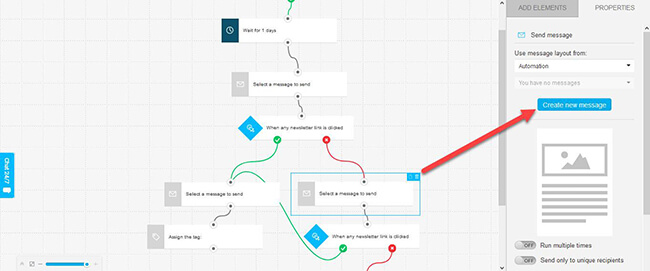
To open the drag and drop builder and compose your message, click the Create new message button.
Conversion funnel
The features listed above are only a sampling of what GetResponse can do for your company.
However, if you want to put everything together, its Conversion Funnel allows you to connect the dots and create a high-converting funnel that is guaranteed to convert visitors into customers.
First, you must determine what your funnel's goal is.
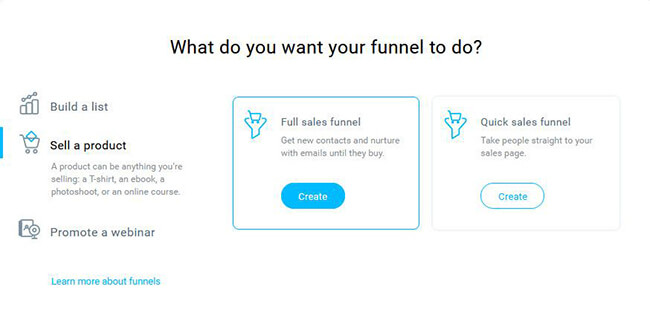
If you want to build a list, GetResponse offers a variety of lead magnets for your funnel. But if you have your own magnet, that's even better.
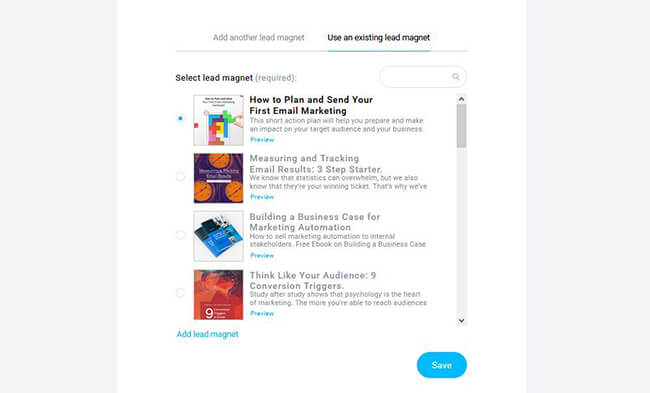
The next page explains what else you need to do to finish the funnel.
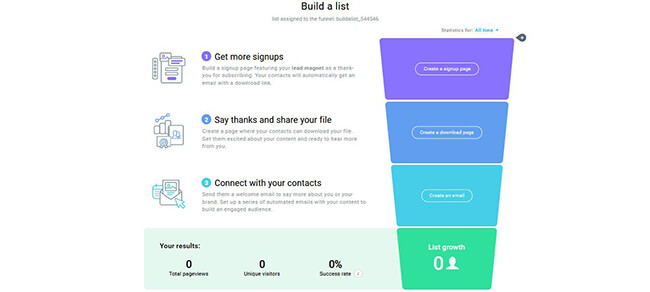
Conversion Funnel eliminates the guesswork involved in creating high-converting campaigns comprised of signup forms, landing pages, and emails.
All you have to do is fill in the blanks and wait for the conversions to come in!
Website builder
That's right, GetResponse can now assist you in the creation of entire websites.
You won't get the same level of flexibility as with dedicated website builders, but for an added bonus? Amazing.
If you need to create a simple website quickly, this is a great option. The AI builder automates the web design process by allowing you to select from a variety of templates based on your industry.
When your basic website is complete, you can further customise it using a drag-and-drop builder.
Ecommerce store
Do you want to sell digital or physical goods? You certainly can.
GetResponse also provides this functionality, which works in tandem with their Conversion Funnel tool.
This means you can create fully functional sales funnels without having to juggle a slew of marketing tools.
What about payment provider integrations? GetResponse integrates with Square, Stripe, PayPal, and other payment processors.
GetResponse pricing
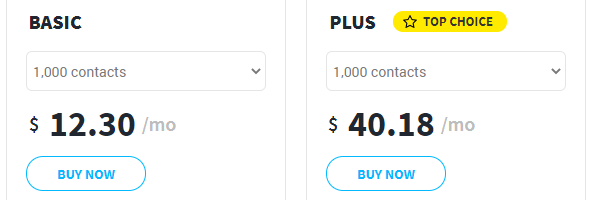
GetResponse provides a free lifetime account with up to 500 contacts and access to email marketing, a website builder (10 pages maximum), and a landing page builder.
Granted, some of these features have feature limitations, but paying will remove these restrictions. However, if you're just getting started, that may be sufficient.
What about paid subscriptions? You have a number of options to choose from. All of them come with a 30-day free trial.
The higher the plan you choose, the more features you'll have access to. In addition, if your subscriber count exceeds 1,000 contacts, the price for all plans rises.
To save money on your subscription, sign up for a 12- or 18-month plan, which will save you 18% and 30%, respectively, off the total price.
The various plans are listed below in alphabetical order.
Basic
GetResponse's most basic plan costs $12.30 per month (paid annually – monthly and 2-year plans available). The following are the features that are included:
- Email marketing, landing pages, forms/surveys, e-commerce tools, templates, website builder, and tracking/reporting are all covered.
- Automation features are limited (drip campaigns, click and open follow-ups, and contact tagging only).
- Create an unlimited number of lead funnels but only one (1) sales funnel.
- Over 150 third-party platform integrations.
- Basic customer service (live chat and email support 24 hours a day, seven days a week).
Plus
The ideal email marketing solution for affiliate marketers looking to grow their businesses. Monthly rates begin at $40.18. (paid annually – monthly and 2-year plans available).
Aside from what is included in the Basic plan, the following items are available in this plan:
- Everything falls under the automation feature, and you can create up to five (5) custom workflows.
- Up to 100 webinar attendees, an unlimited number of registrants, an unlimited number of live webinars, and three (3) hours of recording storage are all available.
- Create an unlimited number of lead funnels, as well as five (5) sales funnels and webinar funnels.
- Create a single account for up to three (3) users (including yourself).
Professional
This plan is recommended for established businesses looking to leverage GetResponse's email marketing and webinar capabilities. Starting at $99 per month ($81.18 per month paid over 12 months and $69.30 per month paid over 18 months).
- Everything falls under the automation feature, as does the ability to create an unlimited number of custom workflows.
- Up to 300 webinar attendees, an unlimited number of registrants, an unlimited number of live webinars, and six (6) hours of recording storage are all available.
- Make an unlimited number of lead funnels, sales funnels, and webinar funnels.
- A single account can have up to five (5) users (including yourself).
- Web push notifications and on-demand webinars are available.
Max
This plan is designed for businesses that want to run their operations using GetResponse's premium features. Sign up for a custom quote to get your price.
Aside from the features of the Professional plan, the following are included in this plan:
- Up to 300 webinar attendees, an unlimited number of registrants, an unlimited number of live webinars, and six (6) hours of recording storage are all available.
- A single account can have up to ten (10) users (including yourself).
- Get campaign and deliverability consulting for the best results.
- Transactional email access (paid add-ons)
- Provide dedicated customer support (24/7 live chat, email, phone, and Slack).
GetResponse advantages and disadvantages
The following is a summary of GetResponse's advantages and disadvantages.
Pros
- There are numerous templates to choose from, allowing you to build almost anything on the platform.
- Nothing is left to the imagination - you can visualise your marketing automation workflows and funnels.
- The conversion funnel feature makes it incredibly simple to create high-converting funnels.
- The webinar feature is self-contained and eliminates the need for a third-party webinar tool.
- You can build websites quickly with a website builder and AI design tool.
Cons
- Building forms is more limited and less intuitive than building emails and landing pages.
- Only Max plan subscribers have access to dedicated customer support.
Frequently asked questions
Is GetResponse a CRM?
GetResponse is not solely a CRM application. However, it allows you to profile and score your contacts in order to identify leads that are ready to convert.
What is the price of GetResponse?
GetResponse costs at least $15 per month for a maximum of 1000 contacts. The price rises as the number of contacts increases or a higher plan is selected.
Which is preferable, Aweber or GetResponse?
AWeber and GetResponse both provide email marketing services. However, GetResponse is the more logical choice due to its lower price point, webinar capabilities, sales funnel builder, and robust marketing automation features.
GetResponse's feature set, on the other hand, may be overkill for some users. AWeber is a good choice if you want a tool that is simple to use.
The final word
Let's wrap up this GetResponse evaluation.
Given the features listed above, it's easy to see why GetResponse is still a top dog in the email marketing industry.
It's difficult to compete with the automation and email marketing services it provides to users.
The abundance of templates for forms, emails, landing pages, workflows, and funnels adds to GetResponse's ease of use.
Even if you don't understand how email marketing software works in general, the templates help you fill in the blanks so you can communicate your message more effectively.
You can also sell both digital and physical products. It can even be used to create simple websites.
GetResponse is a full-stack marketing tool unlike any we've tested. Without having to juggle 8+ different tools, you have everything you'll need in one tool to build a profitable business.
However, GetResponse is not for everyone. If you're just looking for a basic email marketing tool, its extensive feature set may seem excessive.
GetResponse is still one of the best options for engaging your audience and converting them into customers. Sign up for a 30-day free trial at the very least to get a feel for it.

0 Comments